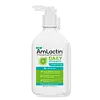What's inside
What's inside
 Key Ingredients
Key Ingredients

 Benefits
Benefits

 Concerns
Concerns

 Ingredients Side-by-side
Ingredients Side-by-side

Water
Skin ConditioningLactic Acid
BufferingEthyl Olivate
EmollientOlive Oil Ethylhexyl Esters
Propylene Glycol
HumectantParaffinum Liquidum
EmollientGlyceryl Stearate
EmollientPEG-100 Stearate
Dimethicone
EmollientGlycerin
HumectantCetyl Alcohol
EmollientSalicylic Acid
MaskingRh-Rice Extract
Skin ConditioningImidazolidinyl Urea
PreservativeXanthan Gum
EmulsifyingMilk Protein
Skin ConditioningChamomilla Vulgaris Extract
Skin ProtectingMelaleuca Alternifolia Leaf Oil
AntioxidantWater, Lactic Acid, Ethyl Olivate, Olive Oil Ethylhexyl Esters, Propylene Glycol, Paraffinum Liquidum, Glyceryl Stearate, PEG-100 Stearate, Dimethicone, Glycerin, Cetyl Alcohol, Salicylic Acid, Rh-Rice Extract, Imidazolidinyl Urea, Xanthan Gum, Milk Protein, Chamomilla Vulgaris Extract, Melaleuca Alternifolia Leaf Oil
Water
Skin ConditioningAmmonium Lactate
BufferingSqualane
EmollientNiacinamide
SmoothingCetearyl Alcohol
EmollientGlycerin
HumectantPropanediol
SolventCoconut Alkanes
EmollientSodium Lactate
BufferingPotassium Lactate
BufferingCandelilla/Jojoba/Rice Bran Polyglyceryl-3 Esters
EmulsifyingGlyceryl Stearate
EmollientCholecalciferol
Tocopheryl Acetate
AntioxidantCeramide NP
Skin ConditioningCeramide AP
Skin ConditioningCeramide EOP
Skin ConditioningGlycereth-5 Lactate
EmollientCholesterol
EmollientCoco-Caprylate/Caprate
EmollientPhytosphingosine
Skin ConditioningXanthan Gum
EmulsifyingHydroxyethyl Acrylate/Sodium Acryloyldimethyl Taurate Copolymer
Emulsion StabilisingSodium Stearoyl Lactylate
EmulsifyingPEG-7 Trimethylolpropane Coconut Ether
EmulsifyingEthylhexylglycerin
Skin ConditioningSodium Lauroyl Lactylate
EmulsifyingPolyisobutene
Phenoxyethanol
PreservativeCarbomer
Emulsion StabilisingPolysorbate 60
EmulsifyingWater, Ammonium Lactate, Squalane, Niacinamide, Cetearyl Alcohol, Glycerin, Propanediol, Coconut Alkanes, Sodium Lactate, Potassium Lactate, Candelilla/Jojoba/Rice Bran Polyglyceryl-3 Esters, Glyceryl Stearate, Cholecalciferol, Tocopheryl Acetate, Ceramide NP, Ceramide AP, Ceramide EOP, Glycereth-5 Lactate, Cholesterol, Coco-Caprylate/Caprate, Phytosphingosine, Xanthan Gum, Hydroxyethyl Acrylate/Sodium Acryloyldimethyl Taurate Copolymer, Sodium Stearoyl Lactylate, PEG-7 Trimethylolpropane Coconut Ether, Ethylhexylglycerin, Sodium Lauroyl Lactylate, Polyisobutene, Phenoxyethanol, Carbomer, Polysorbate 60
Ingredients Explained
These ingredients are found in both products.
Ingredients higher up in an ingredient list are typically present in a larger amount.
Glycerin is already naturally found in your skin. It helps moisturize and protect your skin.
A study from 2016 found glycerin to be more effective as a humectant than AHAs and hyaluronic acid.
As a humectant, it helps the skin stay hydrated by pulling moisture to your skin. The low molecular weight of glycerin allows it to pull moisture into the deeper layers of your skin.
Hydrated skin improves your skin barrier; Your skin barrier helps protect against irritants and bacteria.
Glycerin has also been found to have antimicrobial and antiviral properties. Due to these properties, glycerin is often used in wound and burn treatments.
In cosmetics, glycerin is usually derived from plants such as soybean or palm. However, it can also be sourced from animals, such as tallow or animal fat.
This ingredient is organic, colorless, odorless, and non-toxic.
Glycerin is the name for this ingredient in American English. British English uses Glycerol/Glycerine.
Learn more about GlycerinGlyceryl Stearate is a mix of glycerin and stearic acid.
It is used to stabilize the mixing of water and oil ingredients. By preventing these ingredients from separating, it can help elongate shelf life. It can also help thicken the product's texture.
As an emollient, it helps soften skin and supports barrier-replenishing ingredients.
In cosmetics, Glyceryl Stearate is often made from vegetable oils or synthetically produced.
This ingredient may not be fungal-acne safe
Fun fact: The human body also creates Glyceryl Stearate naturally.
Learn more about Glyceryl StearateWater. It's the most common cosmetic ingredient of all. You'll usually see it at the top of ingredient lists, meaning that it makes up the largest part of the product.
So why is it so popular? Water most often acts as a solvent - this means that it helps dissolve other ingredients into the formulation.
You'll also recognize water as that liquid we all need to stay alive. If you see this, drink a glass of water. Stay hydrated!
Learn more about WaterXanthan gum is used as a stabilizer and thickener within cosmetic products. It helps give products a sticky, thick feeling - preventing them from being too runny.
On the technical side of things, xanthan gum is a polysaccharide - a combination consisting of multiple sugar molecules bonded together.
Xanthan gum is a pretty common and great ingredient. It is a natural, non-toxic, non-irritating ingredient that is also commonly used in food products.
Learn more about Xanthan Gum